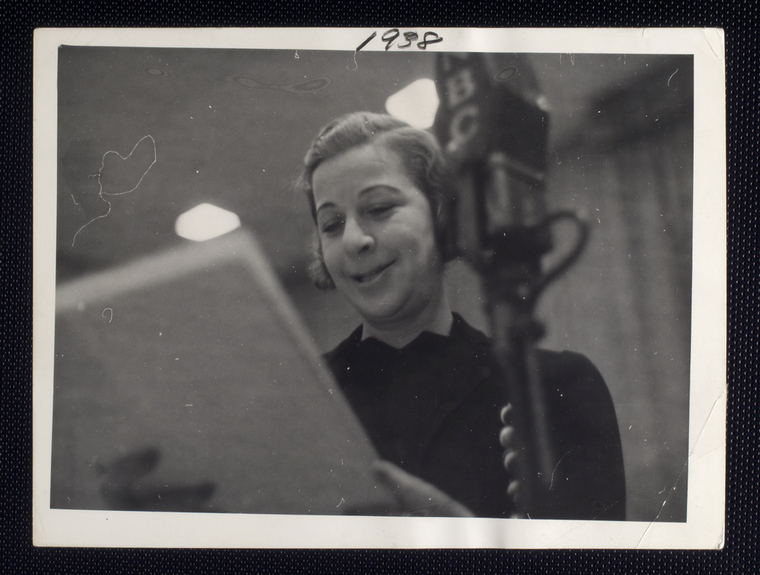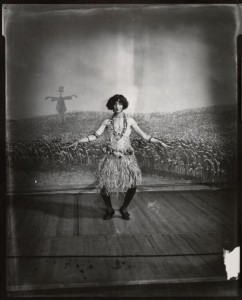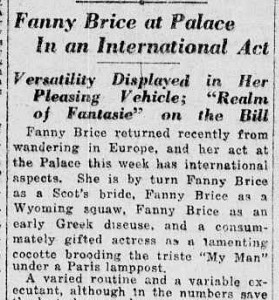Blog Archive
Make ‘Em Laugh

Fanny Brice at the Billy Rose Theatre, 1938. Photo from the New York Public Library Digital Collection
Before Tina Fey and Amy Poehler, before Madeline Kahn and Gilda Radner, before Lucille Ball and Carol Burnett – there was Fanny Brice, the first Queen of Comedy. The original funny girl. While the Tenement Museum focuses on the ordinary lives of ordinary immigrants, this wouldn’t be New York City without every so often a larger-than-life figure coming along to change everything. It’s safe to say Fanny Brice set a precedent for the versatility and gumption for every female comedian since, whose life became the source of the hit Broadway musical and 1968 movie, Funny Girl.

Fanny Brice in the stage production Ziegfeld Follies of 1924. Photo from the New York Public Library Digital Collections.
Born on Forsyth Street on the Lower East Side in 1891, Brice – born Fania Borach – was the third child of Hungarian Jewish immigrants. Her mother worked in a fur factory and her father in a Bowery saloon, so one could imagine her yearning for stardom started early. Her first real taste of the spotlight occurred at the age of 13, when she won an amateur night competition at the Keeney Theater in Brooklyn. She left that night $5 richer and a foot forward on the road to the Ziegfeld Follies, a popular theater production company on Broadway. Her work at the Follies would lead to her becoming a household name, as she performed there on and off for the better part of a decade.
It’s important to note that ethnic comedy was widely prevalent in theater circuits during this time. Capitalizing on and exploiting ethnic stereotypes were very much the norm, and although Brice did not set out to become a “Jew comic” of the day (one of the main reasons behind her name change, in fact), she gained most of her fame and notoriety through Jewish comedy. While Brice was certainly not an unattractive woman, she did not possess the typical beauty standards of the day, so she decided early on if she couldn’t be the prettiest girl on stage, she would be the funniest. Much of her act involved clowning around, accents and impersonations (including a Yiddish accent), and physical comedy that put her a step beyond other performers during that period.
But Brice’s life wasn’t all slapstick and humor. She was a talented singer, and longed for a dramatic career. She also had a tumultuous personal life. She met her husband, Jules Wilford “Nick” Arnstein in 1912 – and loved him deeply despite his career as a con man and criminal. He wasn’t faithful (he was in fact still married to another woman when he married Brice in 1918), and having spent time in Sing Sing in 1915 and Leavenworth in 1924, he disappeared from her life and their two children’s lives entirely. Yet during all the criminal activity, court hearings, and jail time, Brice stood by him. Her devotion to Arnstein was encompassed by one of her signature numbers, “My Man”, where she dropped her comedic act and performed with total seriousness, and it was a performance that often brought audiences to their feet.
After some unsuccessful attempts at more dramatic roles – and a film career that never took off – she returned to the stage in the Ziegfeld Follies of 1934 and 1936. In that time, she created many unique and hilarious characters that showcased her range of talent. But it was one in particular that would lead her to national acclaim – Baby Snooks.
In 1938, she began recording a weekly radio program where she played Baby Snooks, a curious but incredibly whiny toddler. It’s very weird listening to Baby Snooks and imagining it coming out of a middle aged woman. But in a time when anti-Semitism was spreading widely throughout the United States, even Brice, who admitted to being pretty uninformed about current events, realized that her cast of Yiddish-accented characters would not give her as large an appeal as Baby Snooks. The program was incredibly popular and ran on and off for over a decade, and was still on the air in 1951 when Brice died of a stroke in Los Angeles.
You know what they say about hindsight. It’s easy, and even fair, to look back on Brice’s career of exaggerating her own ethnicity and the stereotypes she — willingly or unwillingly — helped perpetrate, and feel uncomfortable with it. It’s also okay to see Fanny Brice still as an inspiration, a Jewish daughter of immigrants who rose to stardom on the merits of her intelligence, talent, and humor, in a time when women and Jews weren’t treated with the utmost respect, to say the least. It’s no fault to look back on previous generations and wish they could have been better, even though we know that cannot change. We can only take what we can from Fanny Brice’s story – how best to take a joke, and how best to tell a joke.
- Post by Gemma Solomons, Marketing & Communications Coordinator at the Lower East Side Tenement Museum
